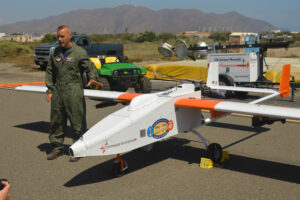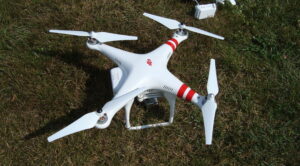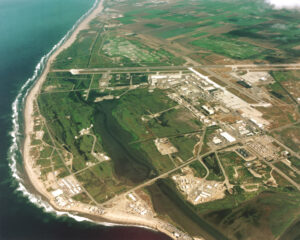Uncle Sam Wants Your Ideas For Stopping Drones: Black Dart Tests
Posted on
WASHINGTON: From July 27 through Aug. 6, the Defense Department is going to conduct a counter-drone testfest — and failure is an option.
“In a sense, failure is free at Black Dart,” said Air Force Maj. Scott Gregg, referring by name to counter-drone tests he is directing for the Joint Integrated Air and Missile Defense Organization (JIAMDO). An annual event started in 2002 by the Defense Intelligence Agency and conducted secretly for more than a decade, this year Black Dart will consist of two weeks of tests at Point Mugu, Calif., of technologies proposed to detect and/or defeat hostile drones. As Hamas illustrated vividly on Thursday, when a mini-drone it claimed as its own crashed on the south side of Gaza’s border after being tracked 40 minutes by Israeli air defenses, the level of the threat posed by hostile Unmanned Aerial Systems (UAS) is going nowhere but up.
Given the need to keep the bad guys from learning what the good guys can do about drones and figuring out ways to get around them, Gregg said, much of what Black Dart has discovered and produced remains highly classified. He did note several successes:
- Tests at Black Dart led SRC Inc. to write new software for its TPQ-50 Counterfire Radar, a mobile system designed to detect and track the source of rocket, artillery and mortar fire, so it now works against drones as well.
- A Boeing AH-64 Apache attack helicopter shot down an Outlaw – a civilian drone with a 13.5-foot wingspan – using an AGM-114 Hellfire missile modified with a proximity fuse.
- A 30 kilowatt shipboard Laser Weapons System later deployed on the USS Ponce amphibious transport dock shot down an Outlaw, proving it can be used against drones as well as other threats.
As in the past, this year’s Black Dart will test defensive systems of all kinds against drones of all sizes, from those as big as the 116-foot wingspan RQ-4 Global Hawk to mini- and micro-drones launched from tubes or even by hand. Gregg said 55 systems will be assessed in tests including opportunities to knock down an Outlaw as it flies over the Point Mugu sea range.

Lt. Cmdr. Shane Tanner of the Joint Integrated Air and Missile Defense Organization talks to the media in 2014 about Tiger Shark, an unmanned aerial system (UAS). This Tiger Shark also carries a smaller UAS that can be launched wihen the Tiger Shark is airborne. Photo by Vance Vasquez / NBVC Public Affairs
Senior leaders decided to lift the curtain on Black Dart last year, Gregg said, to “demonstrate to myriad audiences that the DOD is actively engaged in assessing and improving our C-UAS (Counter-UAS) capabilities and will continue to work to ensure that our adversaries’ UAS capabilities do not outpace our knowledge and understanding of them.”
Contrary to the norm in defense acquisition, Gregg told BD, “Systems can come out, and if the system doesn’t work against a certain threat or a certain profile that they’re examining, they don’t have to report it in testing as a failure and risk funding or support for a program.” There are no limits on what the Black Dart organizers are willing to consider: “We’re open to looking at anything that anyone brings out there.”
Contractors, academics and military and defense organizations all take part in the tests. They provide the systems and pay their own way. “Our organization pays for the range time and all the range services,” Gregg said. “We provide surrogate targets for all of these systems to come and track to assess their own capabilities and, in some cases, take it out.”
“It’s a concern for all of our combatant commanders, especially if they have fielded ground forces,” Gregg said. Domestically, he said, “It’s kind of a shared concern among DOD and DHS (Department of Homeland Security) and the Department of Energy in particular.”
JIAMDO also pays for a tactical data link and communications network that lets all the systems contribute their system data so they share the “air picture.” JIAMDO’s $4.2 million budget for the event also pays for a Joint Staff assessment of the results.
“The big difference this year is that there is a little bit more emphasis on the smaller UAS,” Gregg said, referring to what DOD has dubbed Low Slow Small (LSS) UAS – drones weighing less than 20 pounds that fly slower than 100 knots and below 15,000 feet. The increased focus on LSS UAS was inspired by the quadcopter that landed on the White House lawn last January and by unidentified drones that recently flew over the Eiffel Tower and nuclear plants in France.
 Little drones are the biggest challenge mainly because they’re hardest to detect. Most are far smaller than the gyrocopter a protestor flew on April 15 past the White House and down the National Mall to the Capitol through the country’s most restricted airspace. Setting radars to detect everything makes it hard to detect big threats. The gyrocopter “fell below the threshold necessary to differentiate aircraft from weather, terrain, birds, and other slow flying objects,” as the commander of NORAD, Adm. William Gortney, told a congressional hearing.
Little drones are the biggest challenge mainly because they’re hardest to detect. Most are far smaller than the gyrocopter a protestor flew on April 15 past the White House and down the National Mall to the Capitol through the country’s most restricted airspace. Setting radars to detect everything makes it hard to detect big threats. The gyrocopter “fell below the threshold necessary to differentiate aircraft from weather, terrain, birds, and other slow flying objects,” as the commander of NORAD, Adm. William Gortney, told a congressional hearing.
Gregg said Black Dart has shown the most promising solution to be “systems of systems” – a sensor fence of radar, electro-optical, infrared and acoustic and other detectors, for example.
Knocking drones down is comparatively easy. Besides guns, missiles and lasers, Black Dart has tested high power microwaves and GPS and radio jamming. But shooting a small drone down requires detecting it in time – not to mention the problem posed by the tactic of launching them in swarms. In urban areas, there’s also the question of collateral damage.
“How do you differentiate between a 10-year-old kid who just doesn’t know any better and is flying something from a hobby shop and somebody who’s flying that identical something from a hobby shop but has nefarious intent?” Gregg asked rhetorically. “You can’t tell that with a radar or an infrared sensor.”
One thing Black Dart has shown, he said, is that there is no black dart. “There’s really not one golden BB or silver bullet out there. There’s not one system that can beat everything.” But after a dozen years in the dark, the sponsors of Black Dart want you to know they’re trying.
Subscribe to our newsletter
Promotions, new products and sales. Directly to your inbox.

